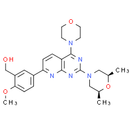Description
KU-0063794 is a potent and selective mTOT inhibitor, which inhibits both mTORC1 and mTORC2 with an IC50 of approximately 10 nM, but does not suppress the activity of 76 other protein kinases or seven lipid kinases, including Class 1 PI3Ks (phosphoinositide 3-kinases) at 1000-fold higher concentrations. KU-0063794 is cell permeant, suppresses activation and hydrophobic motif phosphorylation of Akt, S6K and SGK, but not RSK (ribosomal S6 kinase), an AGC kinase not regulated by mTOR. Ku-0063794 also inhibited phosphorylation of the T-loop Thr308 residue of Akt phosphorylated by PDK1 (3-phosphoinositide-dependent protein kinase-1). Ku-0063794 will be useful in delineating the physiological roles of mTOR and may have utility in treatment of cancers in which this pathway is inappropriately activated.
Product information
CAS Number: 938440-64-3
Molecular Weight: 465.54
Formula: C25H31N5O4
Synonym:
KU0063794
KU 0063794
KU63794
KU 63794
KU-63794
KU-0063794
Chemical Name: (5-(2-((2R, 6S)-2, 6-dimethylmorpholino)-4-morpholinopyrido[2, 3-d]pyrimidin-7-yl)-2-methoxyphenyl)methanol
Smiles: COC1=CC=C(C=C1CO)C1C=CC2=C(N=1)N=C(N=C2N1CCOCC1)N1C[C@H](C)O[C@H](C)C1
InChiKey: RFSMUFRPPYDYRD-CALCHBBNSA-N
InChi: InChI=1S/C25H31N5O4/c1-16-13-30(14-17(2)34-16)25-27-23-20(24(28-25)29-8-10-33-11-9-29)5-6-21(26-23)18-4-7-22(32-3)19(12-18)15-31/h4-7,12,16-17,31H,8-11,13-15H2,1-3H3/t16-,17+
Technical Data
Appearance: Solid Power
Purity: ≥98% (or refer to the Certificate of Analysis)
Solubility: DMSO: 16 mg/mL(34.36 mM). Water: Insoluble.
Shipping Condition: Shipped under ambient temperature as non-hazardous chemical or refer to Certificate of Analysis
Storage Condition: Dry, dark and -20 oC for 1 year or refer to the Certificate of Analysis.
Shelf Life: ≥12 months if stored properly.
Stock Solution Storage: 0 - 4 oC for 1 month or refer to the Certificate of Analysis.
Drug Formulation: To be determined
HS Tariff Code: 382200
How to use
In Vitro:
Compared with the mTOR inhibitor PP242, KU-0063794 exhibits higher specificity for mTOR, as being inactive against PI3Ks or 76 other kinases. In HEK-293 cells, KU-0063794 at 30 nM is sufficient to rapidly ablate S6K1 activity by blocking the phosphorylation of the hydrophobic motif (Thr389) and subsequently the phosphorylation of the T-loop residue (Thr229). In case of IGF1 stimulation of serum-starved HEK-293 cells, 300 nM of KU-0063794 is needed to inhibit the S6K1 activity by ~90%. KU-0063794 at 100-300 nM also completely inhibits the amino-acid-induced phosphorylation of S6K1 and S6 protein. Similar to S6K1, KU-0063794 inhibits the phosphorylation of mTORC1 at Ser2448 and mTORC2 at Ser2481 in a dose-dependent and time-dependent manner. In the presence of serum or following IGF1 stimulation, KU-0063794 induces a dose-dependent inhibition of the activity and phosphorylation of Akt at Ser473 and unexpected Thr308 as well as the phosphorylation of the Akt substrates PRAS40 at Thr246, GSK3α/GSK3β at Ser21/Ser9 and Foxo-1/3a at Thr24/Thr32. KU-0063794 but not rapamycin inhibits SGK1 activity and Ser422 phosphorylation as well as its physiological substrate NDGR1 in a dose-dependent manner, to the same extent as S6K1 and Akt phosphorylation, whereas KU-0063794 dose not inhibit phorbol ester induced ERK or RSK phosphorylation and RSK activation. Compared with rapamycin, KU-0063794 exhibits more significant potency to induce the complete dephosphorylation of 4E-BP1 at Thr37, Thr46 and Ser65. KU-0063794 inhibits cell growth of both wild-type and mLST8-deficient MEFs and induces a G1 cell cycle arrest, more significantly than rapamycin.
In Vivo:
Ku0063794 inhibits tumor growth and mTOR signaling in a preclinical renal cell carcinoma model. However, Ku0063794 was not more effective than temsirolimus in the animal study. A possible explanation for lack of greater activity in vivo for Ku0063794 is that temsirolimus has important effects on the tumor microenvironment. Temsirolimus decreased angiogenesis in the xenograft tumors while Ku0063794 did not. Temsirolimus treated tumors expressed less VEGF and PDGF than Ku0063794 treated tumors, thus stimulating less angiogenesis.
References:
- García-Martínez JM, et al. Biochem J, 2009, 421(1), 29
- Zhang H, et al. PLoS One. 2013, 8(1):e54918.
Products are for research use only. Not for human use.
Payment & Security
Your payment information is processed securely. We do not store credit card details nor have access to your credit card information.


